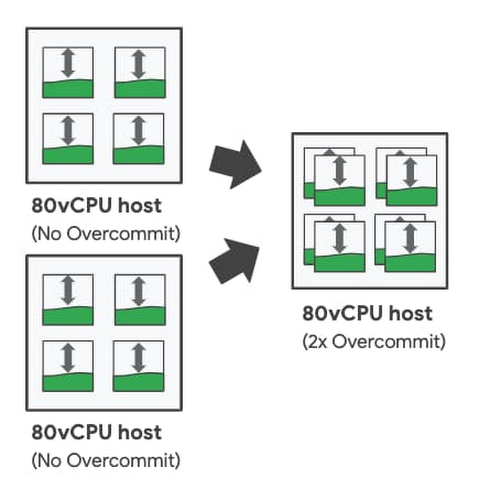In a recent blog post, Google announced that CPU overcommit for sole-tenant nodes is generally available. With CPU overcommit for sole-tenant nodes, customers can over-provision their dedicated host virtual CPU resources by up to two times.
Two years ago, Google announced the beta availability of sole-tenant nodes on Google Compute Engine as an option for customers to have their Virtual Machines (VM) on a dedicated physical host, i.e. an entire Google Compute Engine for their use. Later in early 2020, the company improved the flexibility of their sole-tenant nodes with a few new features such as node group autoscaler, migration between multi- and sole tenant nodes, and live migration within a fixed node pool for bringing your own license (BYOL). And recently, the company made CPU Overcommit for sole-tenant nodes generally available.
Enabling CPU Overcommit for sole-tenant nodes leads to automatic reallocation of virtual CPUs across sole-tenant nodes from idle VM instances to VM instances that need additional resources. Users can set on the VM instance level the minimum number of guaranteed virtual CPUs per VM along with the maximum burstable virtual CPUs per VM. Thus, users can manage VM sizes and overcommit levels on a single sole-tenant node to meet their specific workload needs.

Source: https://cloud.google.com/blog/products/compute/cpu-overcommit-for-sole-tenant-nodes-now-ga
According to the blog post, with CPU overcommit for sole-tenant nodes, enterprises can address common challenges such as:
- Running cost-effective virtual desktops in the cloud by intelligently sharing resources across VMs based on usage when dedicated hardware requirements from licensing requirements exist.
- Efficiently use hosts and minimize infrastructure costs by fully utilizing the hosts CPUs. Furthermore, when using custom machine types, CPU Overcommit helps optimize memory usage and supports higher utilization for workloads with lower memory footprints.
- Reducing licensing costs by allowing enterprises to place more VMs on a licensed server, which also means leveraging on-premise license constructs.
Lastly, CPU Overcommit also offers users detailed metrics to monitor their VM instances to help them better tune their instance overcommit settings. And with the built-in Scheduler Wait Time metric available in Cloud Monitoring, users can view instance-level wait-time statistics to see the impact of oversubscription on their workload.
Holger Mueller, principal analyst and vice president at Constellation Research Inc., told InfoQ:
Loads often are not as predictable as enterprises think and expect, especially in pandemic times. That is a concern when they operate on dedicated instances. It is good to see Google addressing this issue with additional compute capacity. This is both a testament for customer orientation as well as the flexibility of the Google architecture.
Currently, the CPU overcommit configured sole-tenant nodes are available on N1 and N2 nodes in regions and zones with sole-tenant node availability. Furthermore, note that according to the documentation sole-tenant nodes that have CPU overcommit selected on their node template are charged an additional 25%. This charge is added to the 10% premium for running VMs on sole-tenant nodes.